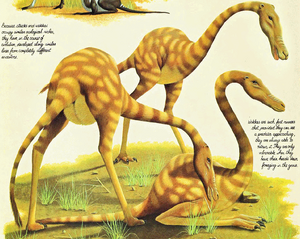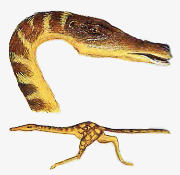
Wakkas are such fast runners that, provided they can see a predator approaching, they are always able to outrun it. They are only vulnerable when they have their heads down foraging in the grass.
The wakka, Anabracchium struthioforme, is a large, somewhat ratite-like, bipedal hydrochoerinae caviid with no front limbs, native to the South American tropical grasslands. It is the most specialized member in the Posthomic South American plains-dwelling rodents, and perhaps the most highly adapted running animal in the world.
Because of its bipedal stance its forelimbs have become less important and are now completely atrophied. Its globular body and long hind legs support an equally long neck and tail which balance one another, maintaining the animal's center of gravity over its hips. These features give the creature a clear view of the surrounding countryside. Even when the wakka is grazing in long grass its eyes are placed high enough on its elongated head for it to see the approach of a predator.

The wakka is bipedal, but unlike the strick it has no front paws to help it keep its balance and instead relies on its tail.
Because stricks and wakkas occupy similar ecological niches, they have, in the course of evolution, developed along similar lines from completely different ancestors.
